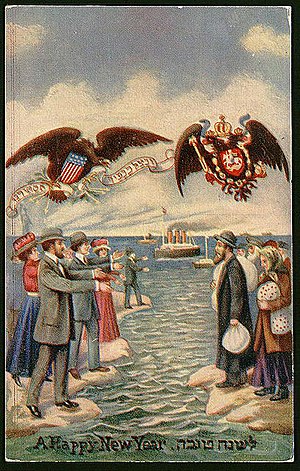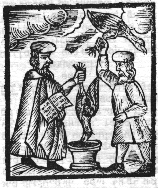 |
| Rosh Hashanah card from 1900. Immigrants from Russia are welcomed to the United States by former immigrants. |
In this post I will concentrate on customs that were practiced in Eastern Europe, but not commonly practiced today in the United States.
The most important Jewish holidays, usually called the High Holidays are celebrated in the early fall, in the month of September. Many customs and practices observed in the United States originated in Eastern Europe. The holidays, begin with Rosh Hashahah and end with Simhat Torah. The most important of the holidays is Yom Kippur, the day of atonement, and the most festive is Simchat Torah, which celebrates the the completion of the reading of the Torah scroll, and the beginning of a new cycle of Torah reading.
 |
| New Year card, sent by Morris and Sarah Gerstein, my husband's grandparents. |
 |
| Sounding the Shofar on Rosh Hashanah |
Rosh Hashanah begins at sundown, with the sounding of the shofar, the ram's horn. In the afternoon of the first day of Rosh Hashanah, during a break in the services, people would gather at a nearby body of water in order to symbolically cast away their sins in the moving water. This is called Tashlikh.
 |
| Tashlikh Ceremony in Poland |
 |
| Tashlikh Ceremony on the Brooklyn Bridge |
 |
| Round Challah and apple for dipping in honey on Rosh Hashanah |
Another custom, widely practiced in Eastern Europe the evening before Yom Kippur was Kaparot. A live white chicken was held over a person's head and swung 3 times as prayers were said. The person's misdeeds and sins were transferred to the chicken, and it was then slaughtered. Either the chicken or the money it brought when sold was donated to charity.
Kreplach, dumplings stuffed with either meat of chicken and cooked in soup, were served the day before Yom Kippur. The kreplach symbolized a persons fate which was hidden and would be decided on Yom Kippur, the day of atonement and judgement.
 |
| An old woodcut showing Kaporot in Eastern Europe. One chicken is swung over the man's head, while the other is slaughtered. |
 |
| "Jews Praying in the Synagogue" Painting by Maurycy Gottlieb, 1878 |
Yom Kippur is the holiest holiday in the Jewish calender. Services begin at sundown and continue the next day until sundown. Many families burn Yarzheit candles at home to remember family members who have died. It is a day of fasting, prayer and reflection. It is believed that God writes every persons name in the Book of Life on Yom Kipppur, deciding who shall live and who shall die. A special Yarzheit, service is offered on Yom Kippur; people recite the Kaddish and remember family members who have passed away. When services are over, the fast is broken at home and special meal is served, usually fish and lighter foods.
 |
| A simple Sukkot hut. |
The holidays end with Simchat Torah, the 7th day of Sukkot and the most festive. This holiday commemorates ending of the annual cycle of weekly Torah readings and the beginning of a new cycle.
The celebration includes parades with the Torah Scrolls around the synagogue, dancing, singing and again special food. Traditionally stuffed cabbage is served on Simchat Torah.
 |
| Old woodcut of Simchat Torah |
 |
| A modern illustration of Simchat Torah festivities, "Simchat Torah" by Israel Bernhaum |

No comments:
Post a Comment